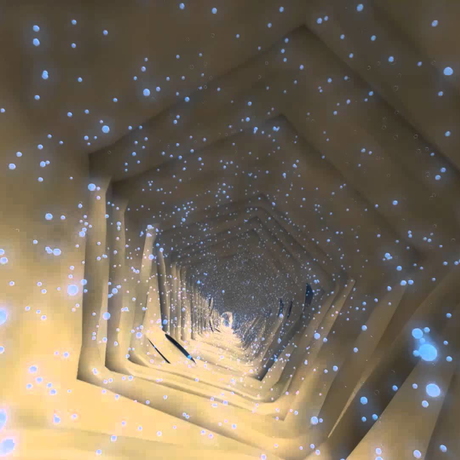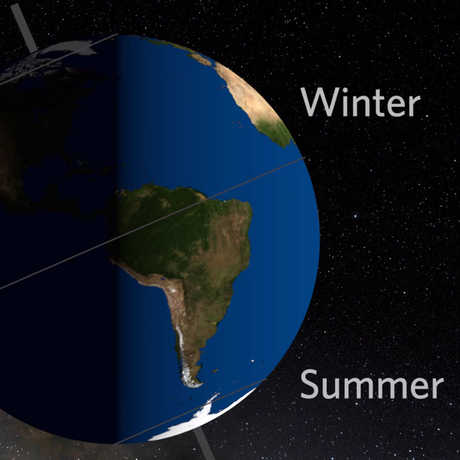Our collection of educational videos will help your students visualize data and understand scientific concepts.
Discover what it means to live in today’s connected world with Habitat Earth, an award-winning film that takes viewers on a journey through the vast networks of life on Earth. Inspire your students with this stunning 25-minute HD film, now available for free for educational use.
Main Themes of the Film
- All life on Earth is part of a complex web of connections within and across ecosystems.
- Humans are inhabitants of a global ecosystem; biological networks intersect with those built by humans.
- Earth's natural systems are sustainable, finding strength in diversity, recycling water and nutrients, and powered by energy from the sun.
Teacher Tip: You can click the Settings cog in the YouTube footer to adjust the Quality to up to 1080HD, and you can also toggle on Full Screen. You can also select Closed Captions in over a dozen languages, including Spanish and Chinese!
Videos and Lessons for Your Classroom
Browse a suite of science-rich media designed specifically for classrooms and informal learning environments, including:
- Short video clips and associated activities featuring stunning visualizations based on large-scale data sets to help students explore environmental principles and concepts
- Model lessons which cover and integrate all three dimensions of the Next Generation Science Standards
- Activities which demonstrate how media can be used in the classroom to engage students in science practices
The Living Soil Beneath Our Feet (3 minute video)
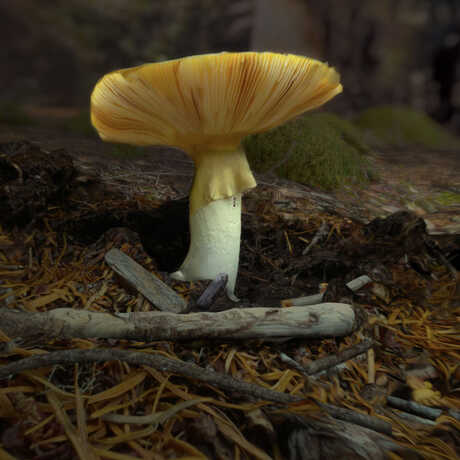
Travel underground for an up-close look at the ants, amoebas, and bacteria that maintain healthy soil. Glimpse this microscopic world and learn about the symbiotic relationship between fungi and tree roots.
Best for Grades 5-12, Life Sciences
- Interdependent Relationships in Ecosystems
- Cycles of Matter and Energy Transfer in Ecosystems
- Organization for Matter and Energy Flow in Organisms
Timelapse: Photosynthesis From Space (2.5 minute video)

How do plants respond to seasonal changes in sunlight? Which areas of our planet are most productive, and why? Witness the influence of the sun on the seasonal abundance of plant matter produced on land and in our oceans.
Best for Grades 5-12, Physical and Life Sciences
- Energy in Chemical Processes and Everyday Life
- Cycles of Matter and Energy Transfer in Ecosystems
- Organization for Matter and Energy Flow in Organisms
Why do birds migrate? (2 minute video)
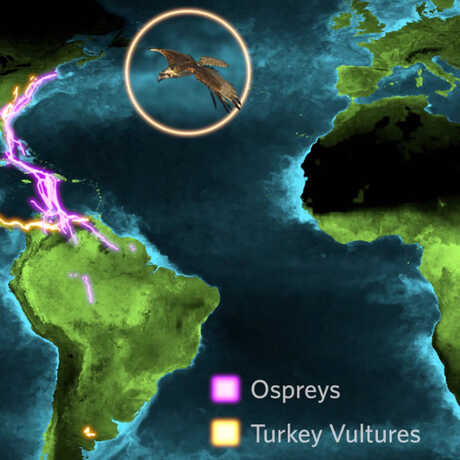
Why do birds migrate? See how seasonal changes and photosynthesis drive patterns in animal behavior. Track the movement of two migratory birds of prey—ospreys and turkey vultures—as they travel between North and South America over a single calendar year.
Best for Grades 5-12, Physical and Life Sciences
- Energy in Chemical Processes and Everyday Life
- Cycles of Matter and Energy Transfer in Ecosystems
- Interdependent Relationships in Ecosystems
How Many Planes Are in the Sky? (1 minute video)
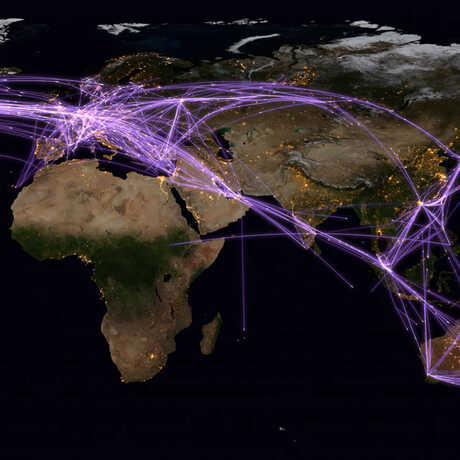
Real-time air traffic reveals modern travel patterns occurring on timescales far more rapid than species migration in the natural world. Illustrating flights taken over two days in September 2013, this series of related clips demonstrates the frequency of plane flights arriving at and departing from airports.
Best for Grades 5-12, Earth Sciences
- Human Impacts on Earth Systems
- Global Climate Change
View data: In North America , In Europe , Around the Globe
How Quickly Do Ships Cross the Oceans? (1 minute video)

Ships cross waters in a matter of days or weeks. Shipping lanes not only connect human societies, but they also connect biological environments through which they pass—often resulting in the transport of invasive species . This series of related clips demonstrates ship traffic over an eleven day period.
Best for Grades 5-12, Life and Earth Sciences
- Human Impacts on Earth Systems
- Ecosystem Dynamics, Functioning, and Resilience
View data: In North America , In Europe, Around the Globe
How Did Human Civilization Spread? (1 minute video)
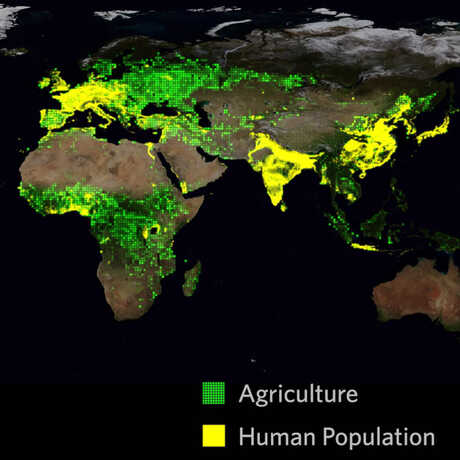
Historic population and cropland data illustrate the relationship between the spread of human civilization and agriculture on Earth between 10,000 BCE and 2,000 CE.
Best for Grades 5-12, Earth Sciences
- Natural Resources
- Human Impacts on Earth Systems
View data: In North America , Around the Globe
Ideas for Using Video in the Classroom
Hook students on the topic
Media can serve as a "hook" that opens up the lesson. Videos can activate prior knowledge, engage the student with something mysterious or visually appealing, or establish a purpose for learning. Lessons that use video clips in this way include:
- Planes, Trains, or Bicycles: Being a Low-impact Traveler (Grades 6-10)
- From Farms to Phytoplankton (Grade 6-11)
Engage students in science practices
Visualizations based on aggregated data provide the unique opportunity to engage your students in various Science Practices highlighted in the Next Generation Science Standards, including asking questions, analyzing and interpreting data, and constructing explanations. Lessons that use video clips in this way include:
- Photosynthesis Seen From Space (Grades 6-10)
- Using Empirical Data in the Classroom: Raptor Migrations! (Grades 6-11)
Reinforce other hands-on lessons
Videos often tell stories that reiterate or reframe science concepts your students are mastering through active, hands-on lessons. Lesson that use video clips in this way include:
- Kinesthetic Astronomy: Longer Days, Shorter Nights (Grades 3-8)
- How Stable is Your Food Web? (Grades 5-8)
Need a list of simple techniques to encourage active viewing of media, or to encourage group sharing?
Free Educator Guides
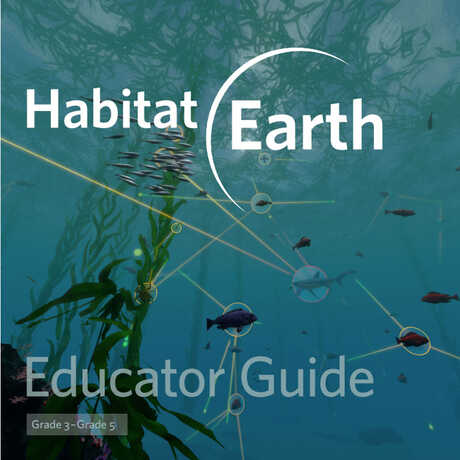
Each guide includes key concepts, glossaries, behind-the-scenes articles, guiding questions and answers, and linkages to the Next Generation Science Standards.
Next Generation Science Standards
Crosscutting Concepts
Consider using one of the below as a lens through which to explore content featured in the full film. Remember that this will affect the specific learning outcome for your students; don't aim to use all three!
- Energy and Matter
- Cause and Effect
- Systems and System Models
Disciplinary Core Ideas
Depending on your grade level and subject matter, your expected use of the full film will undoubtedly differ from other K-12 teachers. Here we list the scientific ideas that shine through in Habitat Earth. Considering focusing on one or more.
Grade 3
» Life Science
- LS4.C: Adaptation
- For any particular environment, some kinds of organisms survive well, some survive less well, and some cannot survive at all.
- LS4.D: Biodiversity and Humans
- Populations live in a variety of habitats, and change in those habitats affects the organisms living there.
Grade 4
» Earth and Space Science
- ESS2.E: Biogeology
- Living things affect the physical characteristics of their regions.
Grade 5
» Life Science
- LS2.A: Interdependence Relationships in Ecosystems.
- The food of almost any kind of animals can be traced back to plants. Organisms are related in food webs. Organisms called decomposers break down dead organisms, recycling some materials back into the soil. A healthy ecosystem is one in which multiple species are able to meet their needs, and newly introduced species can damage the balanceof an ecosystem.
- LS2.B: Cycles of Matter and Energy Transfer in Ecosystems
- Matter cycles between the air and soil and among plants, animals, and microbes as these organisms live and die.
» Earth and Space Science
- ESS3.C: Human Impacts on Earth Systems
- Human activities have had major effects on the land, vegetation, streams, ocean, and air. But individuals and communities are doing things to help protect Earth’s resources and environments.
Middle School
» Life Science
- LS1.C: Organization for Matter and Energy Flow in Organisms
- Plants, algae (including phytoplankton), and many microorganisms use energy from light to make sugars through the process of photosynthesis.
- LS2.A: Interdependent Relationships in Ecosystems
- Organisms, and populations of organisms, are dependent on their environmental interactions both with other living things and with nonliving factors.
- LS2.B: Cycles of Matter and Energy Transfer in Ecosystems
- Food webs are models that demonstrate how matter and energy is transferred between produces, consumers and decomposers.
- LS2.C: Ecosystem Dynamics, Functioning, and Resilience
- Ecosystems vary overtime; disruptions to physical or biological components can lead to shifts in all its populations.
- LS4.D: Biodiversity and Humans
- Changes in biodiversity can influence humans’ resources.
» Earth and Space Science
- ESS2.C: The Roles of Water in Earth’s Surface Processes
- Water continually cycles among land, ocean, and atmosphere.
- ESS3.C: Human Impacts on Earth Systems
- Human activities have significantly altered the biosphere.
High School
» Life Science
- LS1.C: Organization for Matter and Energy Flow in Organisms
- The process of photosynthesis converts light energy to stored chemical energy.
- LS2.C: Ecosystem Dynamics, Functioning, and Resilience
- Anthropogenic changes in the environment can disrupt an ecosystem and threaten the survival of some species.
- LS4.C: Adaptation
- Changes in the physical environment, whether naturally occurring or human induced, have contributed to the expansion of some species, emergence of new species and decline—and sometimes extinction—of some species.
- LS4.D: Biodiversity and Humans
- Humans depend on the living world for the resources and other benefits provided by biodiversity. Human activity is also having adverse impacts on biodiversity. Sustaining biodiversity is essential to supporting and enhancing life on Earth.
» Earth and Space Science
- ESS3.C: Human Impacts on Earth Systems
- The sustainability of human societies and the biodiversity that supports them requires responsible management of natural resources.
- ESS3.D: Global Climate Change
- Though the magnitudes of human impacts are greater than they have ever been, so too are human abilities to model, predict, and manage current and future impacts. Important discoveries are still being made about how the ocean, the atmosphere, and the biosphere interact and are modified in response to human activities.
Our award-winning planetarium shows are now available for educators to stream directly to your classroom.
The W. Richard Bingham Family provides generous support for online educational materials for teachers.

